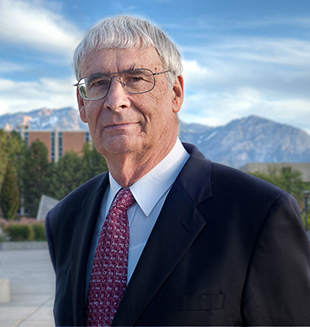

Peter Stang (1941 )
“This is the only country in the world that I know of that takes the best of anyone in the world and
gives them the opportunity to succeed.”
–Peter Stang
National Medal of Science (NMS) recipient in 2010 “for his creative contributions to the development of organic supramolecular chemistry and for his outstanding and unique record of public service.”
Peter Stang was born to a German mother and Hungarian father in Nuremberg, Germany. He lived in Hungary for most of his young childhood, where he was fascinated by chemistry. In school, he took rigorous mathematics and science courses. At home, he made black gunpowder from ingredients at the drugstore, and developed a pH indicator from the juice of red cabbage that his mother cooked, and sold to his “fellow chemists”.
In 1956, when Stang was in the middle of his sophomore year in high school, he and his family fled the Soviet invasion of Hungary and settled in Chicago, Ill. Stang, who did not speak English, failed his American history and English courses, but scored at the top of his class in science and math.
His teachers were confused by his performance and gave him an IQ test. Stang was confused by the unfamiliar format of the test and scored a 78. Despite this challenging high-school experience, Stang was admitted to DePaul University and earned his undergraduate degree in 1963. He received his Ph.D. in 1966 from the University of California, Berkeley.
In 1969, Stang joined the faculty at the University of Utah, where he has since served as chair of the Department of Chemistry and dean of the College of Science. Over the past four decades, Stang has conducted pioneering research in a field known as supramolecular chemistry, in which small molecules are created that can recognize each other and combine to make much more complex molecules.
“It’s like a Lego set with individual building units,” Stang has explained. “You can make complicated structures and systems.” The implications of these molecules are far reaching, from the targeted delivery of cancer drugs to quicker chemical reactions in oil refining.
Stang cites his family and his students as life’s greatest joys. He and his wife have been married since 1969 and their two daughters are both in the medical field.
Stang still takes pleasure in teaching undergraduate organic chemistry and trusts his students so much, that two of his former undergraduates are now his physician and dentist. Stang describes the graduate students in his laboratory as being given “a lot of independence and a lot of latitude.” They are encouraged to take leadership roles in solving problems and generating new ideas.
Upon receiving the NMS, Stang expressed gratitude for the contributions of his students.
“To date,” he remarked, “I have had approximately 100 postdoctoral students and Ph.D. students whom I mentored, and this recognizes their work too.”
Image descriptions and credits
Any opinions, findings, conclusions or recommendations presented in this material are only those of the presenter grantee/researcher, author, or
agency employee; and do not necessarily reflect the views of the National Science Foundation.


